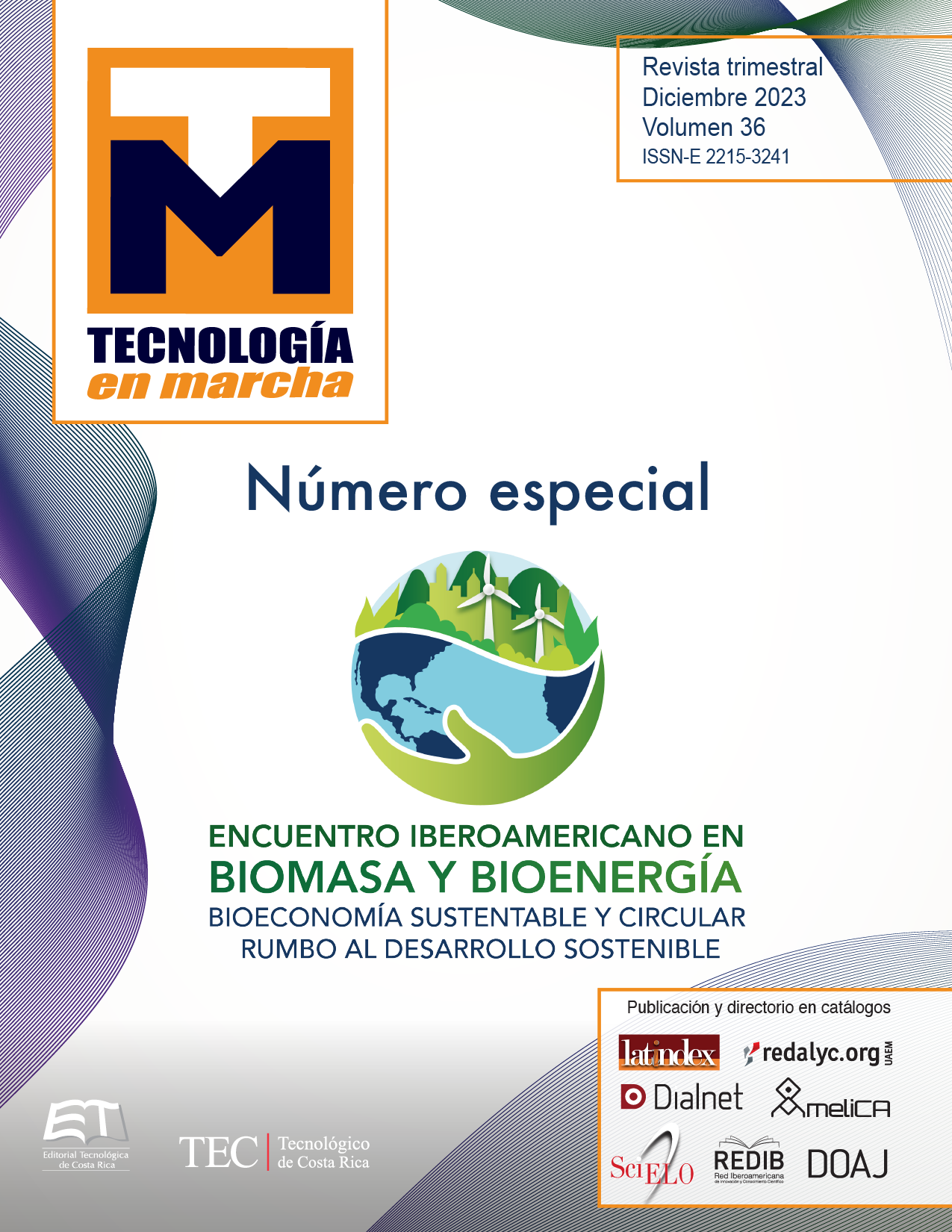Estudio de la exotermicidad y el balance de agua de la carbonización hidrotérmica de poda de césped fresco
Contenido principal del artículo
Resumen
Este estudio ha explorado la viabilidad de realizar la hidrocarbonización de un residuo biomásico ampliamente presente en áreas urbanas, como es el caso del césped obtenido directamente de las labores de poda. Se ha considerado la utilización del material en su estado natural, con la totalidad de su contenido de humedad. De manera específica, se ha buscado aprovechar el agua inherente al material como medio para llevar a cabo la carbonización hidrotérmica. La investigación, realizada en un autoclave para hidrocarbonización (200-220 ºC), permitió estudiar cómo la carga inicial (18-54 g) afecta al poder calorífico del hidrocarbonizado, que por su parte posee propiedades cercanas a las de los materiales carbonosos obtenidos mediante biomasas lignocelulósicas clásicas (el poder calorífico, en torno a 20-22 MJ/kg, supuso un aumento de 200% respecto al césped inicial) y el proceso fue más reactivo a mayor temperatura. El seguimiento de la presión y la temperatura durante el proceso permitieron además identificar etapas de exotermicidad durante la hidrocarbonización, encontrando aumentos de temperatura en torno a 20 ºC (más acentuado a mayor temperatura). Asimismo, se verificó que aumentar el tiempo de enfriamiento promueve las reacciones de recombinación secundarias entre las moléculas de degradación del líquido, aumentando la fase sólida obtenida. Por tanto, aplicar el proceso de carbonización hidrotérmica a residuos como la poda de césped da lugar a la obtención de materiales carbonosos que rondan valores de poderes caloríficos entre 24-26 MJ/Kg que compiten con biocombustibles tipo briqueta obtenidos a partir de otras biomasas por estos mismos procesos. Además, los hidrocarbonizados obtenidos pueden emplearse como enmienda en suelos o como precursores en carbón activado.
Detalles del artículo

Esta obra está bajo una licencia internacional Creative Commons Atribución-NoComercial-SinDerivadas 4.0.
Los autores conservan los derechos de autor y ceden a la revista el derecho de la primera publicación y pueda editarlo, reproducirlo, distribuirlo, exhibirlo y comunicarlo en el país y en el extranjero mediante medios impresos y electrónicos. Asimismo, asumen el compromiso sobre cualquier litigio o reclamación relacionada con derechos de propiedad intelectual, exonerando de responsabilidad a la Editorial Tecnológica de Costa Rica. Además, se establece que los autores pueden realizar otros acuerdos contractuales independientes y adicionales para la distribución no exclusiva de la versión del artículo publicado en esta revista (p. ej., incluirlo en un repositorio institucional o publicarlo en un libro) siempre que indiquen claramente que el trabajo se publicó por primera vez en esta revista.
Citas
H. Son Le, W. Chen, S. Forruque Ahmed, Z. Said, N. Rafa, A. Tuan Le, Ü. Ağbulut, I. Veza, X. Phuong Nguyen, X. Quang Duong, Z. Huang, A. Tuan Hoang, “Hydrothermal carbonization of food waste as sustainable energy conversion path”, Bioresource Technology, vol 363, 127958, pp. 1-14, 2022.
Y. Cao, M. He, S. Dutta, G. Luo, S. Zhang, D.C.W. Tsang, “Hydrothermal carbonization and liquefaction for sustainable production of hydrochar and aromatics”, Renewable and Sustainable Energy Reviews, vol 152, 111722, pp. 1-18, 2021.
L. Suárez, I. Benavente-Ferraces, C. Plaza, S. de Pascual-Teresa, I. Suárez-Ruiz, T.A. Centeno, “Hydrothermal carbonization as a sustainable strategy for integral valorisation of apple waste”, Bioresource Technology, vol 16, 123398, pp. 1-8, 2020.
N. Saha, K. McGaughy, M. Toufiq Reza, “Assessing hydrothermal carbonization as sustainable home sewage management for rural counties: A case study from Appalachian Ohio”, Science of The Total Environment, vol 26, 146648, pp.1-9, 2021.
S. Román, J. Libra, N. Berge, E. Sabio, K. Ro, L. Li, B. Ledesma, A. Álvarez, S. Bae, “Hydrothermal Carbonization: Modeling, Final Properties Design and Applications: A Review”, Energies, vol 11, no 216, pp. 1-28, 2018.
S. Román, B. Ledesma, A. Álvarez, C. Coronella, S.V. Qaramaleki, “Suitability of hydrothermal carbonization to convert water hyacinth to added-value products”, Renewable Energy, vol 146, pp. 1649-1658, 2020.
M. Olivares, S. Román, B. Ledesma, A. Álvarez, “Magnetic Behavior of Carbon Materials Made from Biomass by Fe-Assisted Hydrothermal Carbonization”, Molecules, vol 24, 3996, pp. 1-13, 2019.
M. Boutaieb, S. Román, B. Ledesma, E. Sabio, M. Guiza, A. Ouederni, “Towards a more efficient Hydrothermal Carbonization: Processing water recirculation under different conditions”, Waste Management, vol 132, pp. 115-123, 2021.
Y. Wang, Y. Li, Y. Zhang, Y. Song, B. Yan, W. Wu, L. Zhong, N. Li, G. Chen, L. Hou, “Hydrothermal carbonization of garden waste by pretreatment with anaerobic digestion to improve hydrohcar performance and energy recovery”, Science of the Total Environment, vol 807, 151014, pp. 1-10, 2022.
Y. Yu, Y. Guo, G. Wang, Y. A. El-Kassaby, S. Sokhansanj, “Hydrothermal carbonization of waste ginkgo leaf residues for solid biofuel production: Hydrochar characterization and its pelletization”, Fuel, vol 324, 124341, pp. 1-10, 2022.
L. Suárez, T.E. Díaz, I. Benavente-Ferraces, C. Plaza, M. Almeida, T.A. Centeno, “Hydrothermal treatment as a complementary tool to control the invasive Pampas grass (Cortaderia selloana)”, Science of The Total Environment, vol. 807, 150796, pp. 1-9, 2022.

